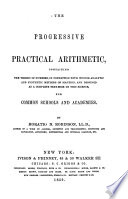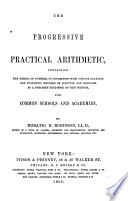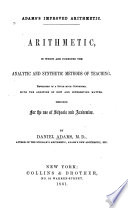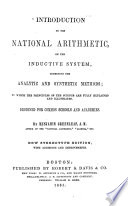 | Horatio Nelson Robinson - Arithmetic - 1859 - 352 pages
...of 6 months on $30, because 30 X 6= 180 X 1. RULE. I. Multiply each payment by its term of credit, and divide the sum of the products by the sum of the payments ; the quotient will be the average term of credit. II. Add the average term of credit to the date at which all the credits begin,... | |
 | Horatio Nelson Robinson - Arithmetic - 1859 - 348 pages
...because 30 X 6 = 180 X 1. RULE. I. Multiply each payment by its term of credit, and divide tfie sum of the products by the sum of the payments ; the quotient will be the average term of credit. Average term of credit. Equated time. Give Case I. Analysis. Rule. II. Add... | |
 | John Daniel Runkle - Mathematics - 1859 - 460 pages
...to the rule commonly used, in the following way. Muttipbj each debt by the time tlwi must intervene before it becomes due, and divide the sum of the products by tlie sum of the debts. The quotient mtt be the interval of time required. If we wish to find the distance... | |
 | Horatio Nelson Robinson - Arithmetic - 1860 - 444 pages
...because 45 X 00 = 270 X 1. Hence the following RULE. I. Multiply each payment by its term of credit, and divide the sum of the products by the sum of the payments; the quotient will be the average term of credit. II. Add the average term of credit to the date at which all the credits begin;... | |
 | Benjamin Greenleaf - Arithmetic - 1860 - 324 pages
...payment of the whole. Hence the following RULE. -—Multiply each payment by its own time, of credit, and divide the sum of the products by the sum of the payments. NOTE 1. — This is the rule usually adopted by merchants, but it is not perfectly correct ; for" if... | |
 | Benjamin Greenleaf - Arithmetic - 1860 - 456 pages
...days, nearly, from May 1, or on June 13. RULE. — Multiply each payment by its own time of credit, and divide the sum of the products by the sum of the payments. NOTE 1. — When the date of the average time of payment is required, as in Example 2, Jind the time... | |
 | Charles Davies - Arithmetic - 1861 - 496 pages
...is, in 8 months : hence, to find the average time of payment : Rule. — Multiply each payment by the time before it becomes due, and divide the sum of...the sum of the payments: the Quotient will be the average time. Examples. 1. A merchant ows $1200, of which $200 is to be paid in 4 months, $400 in 10... | |
 | Daniel Adams - Arithmetic - 1861 - 452 pages
...Hence, To find the mean time of several, payments, — RULE. Multiply each sum by its tune of payment, and divide the sum of the products by the sum of the payments ; the quotient will be the equated tune. EXAMPLES. 2. A Western merchant owes in New York city $200, due in 5 months ; $325'50,... | |
 | Benjamin Greenleaf - Arithmetic - 1861 - 338 pages
...payment of the whole. Hence the following RULE. — Multiply each payment by its own time of credit. and divide the sum of the products by the sum of the payments. NOTE 1. — This is the rule usually adopted by merchants, but it is not perfectly correct ; for if... | |
 | Education - 1861 - 712 pages
...starting point. The rule for Equation of Payments is, " multiply each payment by its own time of credit, and divide the sum of the products by the sum of the payments," — another case in point. I have put down some of the more prominent faults in the books, frankly... | |
| |